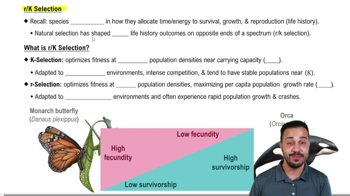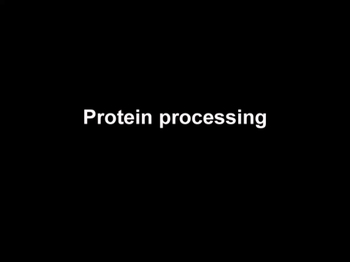Table of contents
- 1. Introduction to Biology2h 42m
- 2. Chemistry3h 40m
- 3. Water1h 26m
- 4. Biomolecules2h 23m
- 5. Cell Components2h 26m
- 6. The Membrane2h 31m
- 7. Energy and Metabolism2h 0m
- 8. Respiration2h 40m
- 9. Photosynthesis2h 49m
- 10. Cell Signaling59m
- 11. Cell Division2h 47m
- 12. Meiosis2h 0m
- 13. Mendelian Genetics4h 44m
- Introduction to Mendel's Experiments7m
- Genotype vs. Phenotype17m
- Punnett Squares13m
- Mendel's Experiments26m
- Mendel's Laws18m
- Monohybrid Crosses19m
- Test Crosses14m
- Dihybrid Crosses20m
- Punnett Square Probability26m
- Incomplete Dominance vs. Codominance20m
- Epistasis7m
- Non-Mendelian Genetics12m
- Pedigrees6m
- Autosomal Inheritance21m
- Sex-Linked Inheritance43m
- X-Inactivation9m
- 14. DNA Synthesis2h 27m
- 15. Gene Expression3h 20m
- 16. Regulation of Expression3h 31m
- Introduction to Regulation of Gene Expression13m
- Prokaryotic Gene Regulation via Operons27m
- The Lac Operon21m
- Glucose's Impact on Lac Operon25m
- The Trp Operon20m
- Review of the Lac Operon & Trp Operon11m
- Introduction to Eukaryotic Gene Regulation9m
- Eukaryotic Chromatin Modifications16m
- Eukaryotic Transcriptional Control22m
- Eukaryotic Post-Transcriptional Regulation28m
- Eukaryotic Post-Translational Regulation13m
- 17. Viruses37m
- 18. Biotechnology2h 58m
- 19. Genomics17m
- 20. Development1h 5m
- 21. Evolution3h 1m
- 22. Evolution of Populations3h 52m
- 23. Speciation1h 37m
- 24. History of Life on Earth2h 6m
- 25. Phylogeny2h 31m
- 26. Prokaryotes4h 59m
- 27. Protists1h 12m
- 28. Plants1h 22m
- 29. Fungi36m
- 30. Overview of Animals34m
- 31. Invertebrates1h 2m
- 32. Vertebrates50m
- 33. Plant Anatomy1h 3m
- 34. Vascular Plant Transport1h 2m
- 35. Soil37m
- 36. Plant Reproduction47m
- 37. Plant Sensation and Response1h 9m
- 38. Animal Form and Function1h 19m
- 39. Digestive System1h 10m
- 40. Circulatory System1h 57m
- 41. Immune System1h 12m
- 42. Osmoregulation and Excretion50m
- 43. Endocrine System1h 4m
- 44. Animal Reproduction1h 2m
- 45. Nervous System1h 55m
- 46. Sensory Systems46m
- 47. Muscle Systems23m
- 48. Ecology3h 11m
- Introduction to Ecology20m
- Biogeography14m
- Earth's Climate Patterns50m
- Introduction to Terrestrial Biomes10m
- Terrestrial Biomes: Near Equator13m
- Terrestrial Biomes: Temperate Regions10m
- Terrestrial Biomes: Northern Regions15m
- Introduction to Aquatic Biomes27m
- Freshwater Aquatic Biomes14m
- Marine Aquatic Biomes13m
- 49. Animal Behavior28m
- 50. Population Ecology3h 41m
- Introduction to Population Ecology28m
- Population Sampling Methods23m
- Life History12m
- Population Demography17m
- Factors Limiting Population Growth14m
- Introduction to Population Growth Models22m
- Linear Population Growth6m
- Exponential Population Growth29m
- Logistic Population Growth32m
- r/K Selection10m
- The Human Population22m
- 51. Community Ecology2h 46m
- Introduction to Community Ecology2m
- Introduction to Community Interactions9m
- Community Interactions: Competition (-/-)38m
- Community Interactions: Exploitation (+/-)23m
- Community Interactions: Mutualism (+/+) & Commensalism (+/0)9m
- Community Structure35m
- Community Dynamics26m
- Geographic Impact on Communities21m
- 52. Ecosystems2h 36m
- 53. Conservation Biology24m
4. Biomolecules
Proteins
Problem 10`
Textbook Question
Make a concept map that relates the four levels of protein structure and shows how they can contribute to the formation of hemoglobin. Your map should include the following boxed terms: Primary structure, Secondary structure, Tertiary structure, Quaternary structure, Amino acid sequence, R-groups, αα-helices, and ββ-pleated sheets.
 Verified step by step guidance
Verified step by step guidance1
Start by defining the primary structure of proteins, which is the linear sequence of amino acids. This sequence is determined by the genetic code and is crucial for the protein's final shape and function.
Next, illustrate the secondary structure, which includes αα-helices and ββ-pleated sheets. These structures are formed by hydrogen bonds between the backbone atoms in the polypeptide chain.
Then, describe the tertiary structure, which is the overall three-dimensional shape of a single polypeptide chain. This structure is stabilized by interactions between R-groups, such as hydrogen bonds, ionic bonds, and disulfide bridges.
Explain the quaternary structure, which involves the assembly of multiple polypeptide chains into a functional protein complex. In the case of hemoglobin, it consists of four subunits, each with its own tertiary structure.
Finally, connect these structures to hemoglobin by showing how the specific amino acid sequence (primary structure) leads to the formation of αα-helices and ββ-pleated sheets (secondary structure), which fold into a specific three-dimensional shape (tertiary structure) and assemble into a multi-subunit complex (quaternary structure) to function effectively in oxygen transport.
 Verified video answer for a similar problem:
Verified video answer for a similar problem:This video solution was recommended by our tutors as helpful for the problem above
Video duration:
1mPlay a video:
Was this helpful?
Key Concepts
Here are the essential concepts you must grasp in order to answer the question correctly.
Protein Structure Levels
Proteins have four levels of structure: primary, secondary, tertiary, and quaternary. The primary structure is the amino acid sequence, secondary involves α-helices and β-pleated sheets, tertiary is the 3D folding due to R-group interactions, and quaternary is the assembly of multiple polypeptides. Each level contributes to the protein's final shape and function.
Recommended video:
Guided course

Protein Structure
Amino Acid Sequence
The amino acid sequence is the linear order of amino acids in a protein, determined by the genetic code. This sequence dictates the protein's primary structure and influences higher-level structures by determining how the protein will fold and interact with other molecules, crucial for hemoglobin's function.
Recommended video:
Guided course

Amino Acids
R-groups and Protein Folding
R-groups are the side chains of amino acids that vary in size, charge, and hydrophobicity. They play a critical role in protein folding, affecting tertiary structure by forming bonds and interactions like hydrogen bonds, ionic bonds, and hydrophobic interactions. These interactions are essential for the stability and functionality of proteins like hemoglobin.
Recommended video:
Guided course

r/K Selection
Related Videos
Related Practice






















